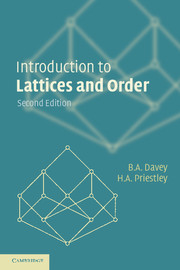Book contents
- Frontmatter
- Contents
- Preface to the second edition
- Preface to the first edition
- 1 Ordered sets
- 2 Lattices and complete lattices
- 3 Formal concept analysis
- 4 Modular, distributive and Boolean lattices
- 5 Representation: the finite case
- 6 Congruences
- 7 Complete lattices and Galois connections
- 8 CPOs and fixpoint theorems
- 9 Domains and information systems
- 10 Maximality principles
- 11 Representation: the general case
- Appendix A: a topological toolkit
- Appendix B: further reading
- Notation index
- Index
6 - Congruences
Published online by Cambridge University Press: 05 June 2012
- Frontmatter
- Contents
- Preface to the second edition
- Preface to the first edition
- 1 Ordered sets
- 2 Lattices and complete lattices
- 3 Formal concept analysis
- 4 Modular, distributive and Boolean lattices
- 5 Representation: the finite case
- 6 Congruences
- 7 Complete lattices and Galois connections
- 8 CPOs and fixpoint theorems
- 9 Domains and information systems
- 10 Maximality principles
- 11 Representation: the general case
- Appendix A: a topological toolkit
- Appendix B: further reading
- Notation index
- Index
Summary
Lattices of congruences play a central role in lattice theory and in algebra more widely. This chapter develops the rudiments of a theory which goes way beyond the scope of an introductory text such as this.
Introducing congruences
In group theory courses it is customary, after homomorphisms have been introduced, to go on to define normal subgroups and quotient groups (factor groups) and to reveal the intimate connection between these concepts that is summed up in the fundamental Homomorphism Theorem (also called the First Isomorphism Theorem). We begin with a summary of the basic group theory results, expressed in a form that will make the parallels with the lattice case stand out clearly. This summary is prefaced by a brief refresher on equivalence relations.
Equivalence relations: a recap. We recall that an equivalence relation on a set A is a binary relation on A which is reflexive, symmetric and transitive. We write a ≡ b (mod θ) or a θ b to indicate that a and b are related under the relation θ we use instead the notation (a, b) ∈ θ where it is appropriate to be formally correct and to regard θ as a subset of A × A.
An equivalence relation θ on A gives rise to a partition of A into non-empty disjoint subsets.
- Type
- Chapter
- Information
- Introduction to Lattices and Order , pp. 130 - 144Publisher: Cambridge University PressPrint publication year: 2002



